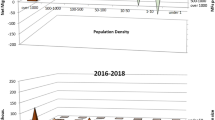Abstract
European Mediterranean cultural and political capitals are undergoing processes of transformation of their urban structures linked to the intensification of international and internal flows of migration and temporary mobility. The presence of migrants, tourists, temporary residents, city users is changing the way in which buildings are utilized, affecting the real estate market, the commercial system, and the infrastructure system. This has resulted in redefinition of the population structure at the metropolitan scale.
This paper considers the metropolitan area of Rome and analyzes population movements during the period 2002–2017 using data relating to the structure of resident population, international and internal changes of residence, and information concerning tourist flows and the real estate market.
Access this chapter
Tax calculation will be finalised at checkout
Purchases are for personal use only
Similar content being viewed by others
Notes
- 1.
Person-years are a combined measure of the number of persons undergoing a given event (in our case: birth, death, and migration) and the time during which they are in the condition of undergoing that event. It is the value placed in the denominator for calculating the rates considered here to express, for each person, the sum of years in the condition of belonging to a given quota or subset of the population (born, deceased, immigrants, emigrants).
References
Berry, B. J., Goheen, P. G., & Goldstein, H. (1969). Metropolitan area definition: A reevaluation of concept and statistical practice. US Bureau of the Census.
Bonifazi, C., Heins, F., & Tucci, E. (2012). Le migrazioni interne degli stranieri al tempo dell’immigrazione. Meridiana, 75, 173–190.
Borsino Immobiliare. (2020). Borsino Immobiliare. Servizi & Valutazioni Immobiliari Nazionali. www.borsinoimmobiliare.it/. Last access: January 2020.
Castellano, M., & Montanari, A. (2020). Latium region, a new tourism for the Litorale Nord Area. Guide to promote the transfer of knowledge. Sapienza Università Editrice.
Champion, A. G. (1989). Counterurbanization in Britain. The Geographical Journal, 155, 52–59.
Cheshire, P. (1995). A new phase of urban development in Western Europe? Urban Studies, 32, 1045–1063.
Crisci, M. (2010). Italiani e stranieri nello spazio urbano. Dinamiche della popolazione di Roma. Franco Angeli.
Cross, D. (1990). Counterurbanisation in England and Wales. Ashgate.
De Muro, M., Monni, S., & Tridico, P. (2011). Knowledge-based economy and social exclusion: Shadow and light in the roman socio-economic model. International Journal of Urban and Regional Research, 35(6), 1212–1238. https://doi.org/10.1111/j.1468-2427.2010.00993.x
Di Feliciantonio, C., & Salvati, L. (2015). ‘Southern’ alternatives of urban diffusion: Investigating settlement characteristics and socio-economic patterns in three Mediterranean regions. Tijdschrift voor Economische en Sociale Geografie, 16(4), 453–470. https://doi.org/10.1111/tesg.12102
European Environment Agency (EEA). (1990). CORINE land cover. Retrieved from: http://www.sinanet.isprambiente.it/it/sia-ispra/download-mais/corine-land-cover
European Environment Agency (EEA). (2012). CORINE land cover. Retrieved from: http://www.sinanet.isprambiente.it/it/sia-ispra/download-mais/corine-land-cover
European Environment Agency (EEA). (2006). Urban sprawl in Europe – The ignored challenge (EEA Report No. 10). Retrieved from: https://www.eea.europa.eu/publications/eea_report_2006_10
ISTAT. (2020). Atlante Statistico dei Comuni. http://asc.istat.it/asc_BL/
Marcelloni, M. (2003). Pensare la città contemporanea. Il nuovo piano regolatore di Roma. Laterza.
Montanari, A., & Staniscia, B. (2012). Italy: Human mobility, urban changes, environmental conflicts. In A. Williams (Ed.), Human mobility in coastal regions: The impact of migration and temporary mobilities on urbanization (pp. 189–258). Sapienza University Press.
Montanari, A., Staniscia, B., & Di Zio, S. (2007). The Italian way to deconcentration. Rome: the appeal of the historic centre, Chieti-Pescara: The strength of the periphery. In E. Razin, M. Dijst, & C. Vazquez (Eds.), Employment deconcentration in European metropolitan areas. Market forces versus planning regulations (pp. 145–178). Springer.
Mudu, P. (2006). Patterns of segregation in contemporary Rome. Urban Geography, 27(5), 422–440. https://doi.org/10.2747/0272-3638.27.5.422
Pacione, M. (2005). Urban geography: A global perspective. Routledge.
Preston, S. H., Heuveline, P., & Guillot, M. (2001). Demography. Measuring and modelling population processes. Blackwell Publishers.
Salvati, L. (2014). Towards a polycentric region? The socio-economic trajectory of Rome, an ‘eternally Mediterranean’ city. Tijdschrift voor Economische en Sociale Geografie, 105(3), 268–284. https://doi.org/10.1111/tesg.12054
Salvati, L. (2015). Lost in complexity, found in dispersion: ‘Peripheral’ development and deregulated urban growth in Rome. Cities, 47, 73–80. https://doi.org/10.1016/j.cities.2015.04.001
Salvati, L. (2016). Demographic transition, immigration, gentrification: Unravelling early signs of re-urbanisation in a European city. International Social Science Journal, 66, 49–62. https://doi.org/10.1111/issj.12120
Salvati, L., & Carlucci, M. (2016). In-between stability and subtle changes: Urban growth, population structure, and the City Life Cycle in Rome. Population, Space and Place, 22, 216–227. https://doi.org/10.1002/psp.1877
Salvati, L., Gargiulo, M. V., Rontos, K., & Sabbi, A. (2013). Latent exurban development: City expansion along the rural-to-urban gradient in growing and declining regions of Southern Europe. Urban Geography, 34(3), 376–394. https://doi.org/10.1080/02723638.2013.778675
Salvati, L., Sateriano, A., Grigoriadis, E., & Carlucci, M. (2017). New wine in old bottles: The changing socioeconomic drivers of sprawl during building boom and stagnation. Ecological Economics, 131, 361–372. https://doi.org/10.1016/j.ecolecon.2016.09.008
Sociometrica. (2020). Il Sommerso ricettivo a Roma, Analisi del mercato degli affitti brevi. EBTL-Ente Bilaterale Turismo del Lazio.
Staniscia, B. (2020). Tourism and urban sustainability in the historic city of Rome: Challenge or threat? In V. Higgins & D. Douglas (Eds.), Communities in heritage, global issues, local values (pp. 146–156). Routledge. (e-book).
Strozza, S., Benassi, F., Ferrara, R., & Gallo, G. (2016). Recent demographic trends in the major Italian agglomerations: The role of foreigners. Spatial Demography, 4, 39–70. https://doi.org/10.1007/s40980-015-0012-2
van den Berg, L., Drewett, R., & Klaassen, L. H. (1982). A study of growth and decline. Pergamon.
Williams, A. M., Foord, J., & Mooney, J. (2012). Human mobility in functional urban regions: Understanding the diversity of mobilities. International Review of Sociology, 22(2), 191–209. https://doi.org/10.1080/03906701.2012.696961
Author information
Authors and Affiliations
Corresponding author
Editor information
Editors and Affiliations
Rights and permissions
Copyright information
© 2021 Springer Nature Switzerland AG
About this chapter
Cite this chapter
Gallo, G., Montanari, A., Staniscia, B., Tucci, E. (2021). International Mobility and Its Spatial Impacts in the Rome Metropolitan Area: An Analysis of the Last Two Decades. In: Dominguez-Mujica, J., McGarrigle, J., Parreño-Castellano, J.M. (eds) International Residential Mobilities. Geographies of Tourism and Global Change. Springer, Cham. https://doi.org/10.1007/978-3-030-77466-0_10
Download citation
DOI: https://doi.org/10.1007/978-3-030-77466-0_10
Published:
Publisher Name: Springer, Cham
Print ISBN: 978-3-030-77465-3
Online ISBN: 978-3-030-77466-0
eBook Packages: Social SciencesSocial Sciences (R0)




